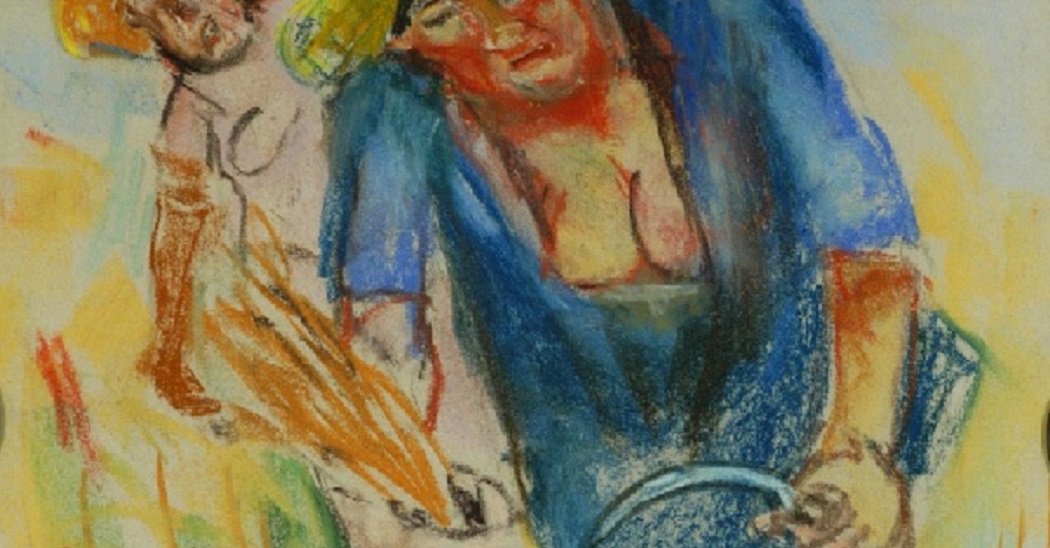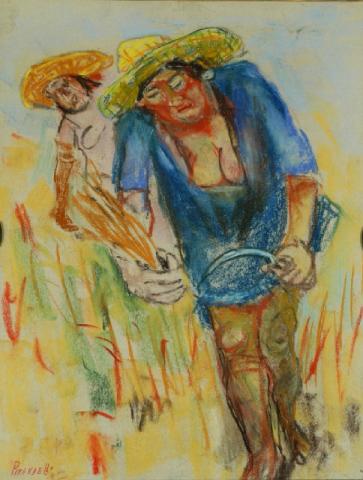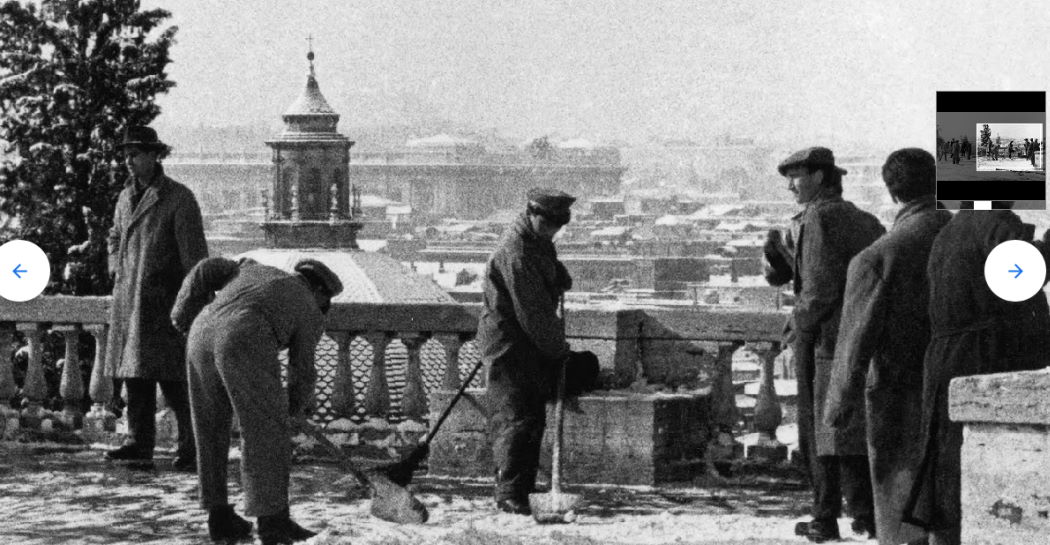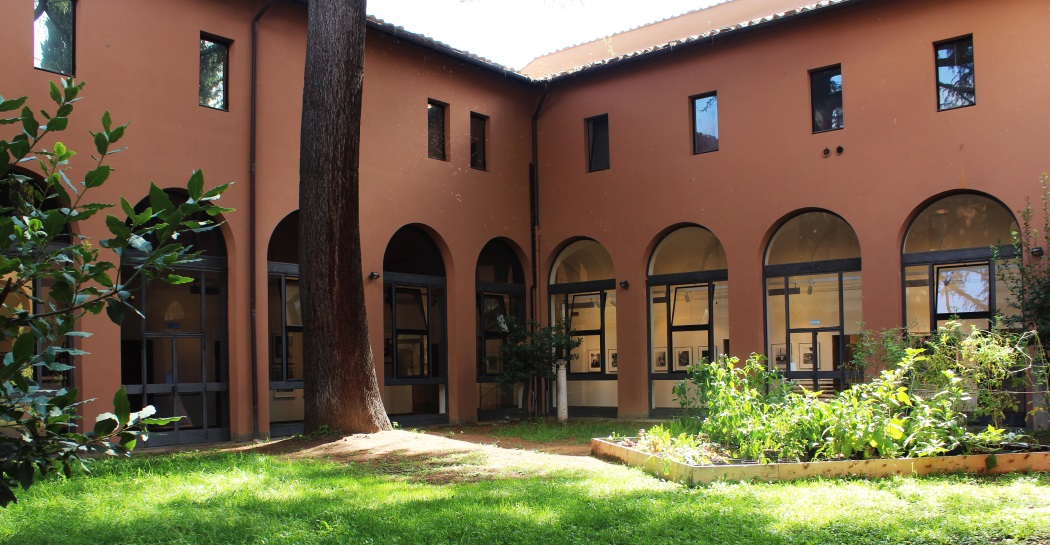The Artwork of the Month - June 2023
Fausto Pirandello (Roma, 1899-1975)
Mietitrice, 1949-1951
Crayon wax crayon on paper
28x21.5 cm

With this drawing by the artist Fausto Pirandello, we wish to pay homage to the harvest, the most awaited event of the year in peasant tradition, with which the summer season opens and which takes place between June and July. With a few swift and compendious strokes, the author fixes the moment in which two women are intent on manually cutting the ears of wheat, with the classic sickle. He succeeds in rendering, at the same time, both the sensual charge of the subjects - particularly the female in the foreground, whose breasts are involuntarily exposed - and the realism of the hard work in the fields, whose fatigue is visible on the woman's flushed face, exposed to the summer heat.
The drawing in the Museo della Scuola Romana, undated, is part of Fausto Pirandello's post-war production, a period in which his research was oriented in an original way along a path that absorbed different stimuli, including futurism, cubism and expressionism. From the 1950s onwards, in particular, Pirandello experimented with very bright chromatic registers, never used before, which are also found in the pastel reproduced here, attributable to the period between the fifth and sixth decade of the 20th century. From the writings left by the artist, we know that he attributes to the pastel technique the expressive power of immediacy, with which he can render the first intuition of his subjects. The themes dedicated to agricultural work, already at the centre of his earlier paintings such as Fienagione (1938) and Siccità (1938), return in later works, such as in Ragazza con la falce (1949, exhibited in 1951 at the VI Quadriennale in Rome) or Donna con la zappa (1951), perhaps inspired by scenes observed during his stays in Grottaferrata, near Rome, where Pirandello habitually went on holiday from 1948, the year he bought a house there. La Mietitrice is part of a group of works on paper by the same author that arrived in the collection of the Museo della Scuola Romana in 2006, thanks to a donation by Dora Immordino Pirandello, wife of Antonio, the artist's second-born son.
Fausto Calogero Pirandello (Rome, 1899-1975) is one of the most significant painters of the 20th century in Italy who, although artistically placing himself among the exponents of the Roman School, stands out for an original personal style and for research conducted autonomously. He uses realist poetics, in which everyday life is expressed with dense and rough painting with expressionist traits, and where even the most brutal aspects are nevertheless crystallised in timeless, metaphysical atmospheres. His closeness to tonal painting evolved in the 1950s, absorbing the suggestions of French cubism, finally arriving at original formal solutions tending towards abstraction.
The youngest son of Maria Antonietta Portolano and Nobel Prize-winning playwright Luigi Pirandello, both from Agrigento, he was born after his brother Stefano and sister Lietta. The Pirandello boys spent their childhood between Rome and holidays in Sicily, the land where Fausto acquired that personal taste for ochre and warm tones that characterised his works. The Pirandello family suffered a serious financial loss in 1903, an event that would aggravate the fragile mental health of his mother, Maria Antonietta, who would spend the last decades of her life, from 1919 to 1959, in a nursing home in Rome. Not an insignificant contingency for the development of Fausto's artistic sensibility. He also had to face the call to arms for the First World War - he was among the boys in 1899 - having to interrupt his classical studies at the Liceo Tasso, although he was not sent to the front for health reasons, and spent the period of the War in hospital. After the war, he did not resume his studies and manifested the desire to devote himself first to sculpture, which he was forced to abandon again due to health problems, and then to painting (already practised at home at an amateur level by both his brother and father). In 1922, he enrolled in the Art School at the Orti Sallustiani, opened in Rome by the artists Felice Carena, Attilio Selva and Orazio Amato. Here he met the painters Emanuele Cavalli, Onofrio Martinelli and Giuseppe Capogrossi, with whom he spent long summer holidays in Anticoli Corrado, a village in the Aniene Valley, already known among the artists of the time for its tradition of model posing, where Fausto opened his first painting studio and where he met the model Pompilia D'Aprile, whom he married in 1927. In 1925 Pirandello made his first public appearance as a painter at the 3rd Roman Biennale, with the work Bagnanti (Bathers), and the following year at the 15th International Art Biennale in Venice, where he would exhibit continuously from 1932 to 1942.
In 1927, the painter decided to settle in Paris, where he went against his father's wishes and where he became the parent of his eldest son, Pierluigi, born in 1928. In the French capital, he acquired new artistic experiences that were fundamental for him: he frequented the group of Italiens de Paris (especially Giorgio de Chirico and Filippo de Pisis) and got to know more closely the works of Cézanne, the Cubists (Picasso and Braque) and the painters of the Paris School (l'École de Paris). In 1930, he returned permanently to Rome with his wife Pompilia and son Pierluigi, taking up residence in Via Valenziani (he would later move to Via degli Scialoja) and spending the summers with his family in Anticoli Corrado. During the 1930s, he frequently exhibited at the Galleria di Roma, the Sindacali del Lazio and the Quadriennali Romane and was linked to the Roman School, within which he was closer to the group of so-called 'tonalists', such as Giuseppe Capogrossi, Emanuele Cavalli and Roberto Melli.
In 1934 he exhibited La scala (The Staircase) at the Venice Biennale, one of the largest and most complex works of this period, which left critics and the public hesitant. However, the climate he encountered was favourable to him, with full recognition of his art arriving from the early 1940s. The loss of his father Luigi occurred in 1936 and Fausto's second son Antonio was born the following year. As wartime events precipitated, in 1942, the Pirandellos moved permanently to Anticoli Corrado, only to return to the capital a couple of years later. The post-war period saw an intensification of Fausto's exhibition activity, with regular participations in the Quadriennali Romane, the Venice Biennials and at private galleries. In 1947, Pirandello was nominated Academician of the Accademia di San Luca, together with Giorgio de Chirico, Ferruccio Ferrazzi and Tullio Bartoli, a sign of the professional consolidation that had taken place. During the 1950s, he exhibited his works in numerous personal exhibitions (such as the anthological exhibition at Palazzo Barberini, in Rome, in 1951) and collective exhibitions, gaining many acknowledgements: he received the First Prize at the 6th National Art Quadriennale in Rome in 1951, the Gualino Prize at the XXVI Venice Biennale in 1952 (which dedicated a personal room to him in the 1956 edition), the Marzotto Prize in 1953, and the Fiorino Prize in 1957. In 1955, Pirandello held his first solo exhibition in the United States, at the Catherine Viviano Gallery in New York. During the 1960s he received yet more national recognition for his long career as an artist: in 1960 Pirandello was among the painters of the Roman School who received awards at the XIII Quadriennale Nazionale d'Arte in Rome; in 1964 he received the Michetti Prize and in 1967 the Villa Prize.
In his last years he devoted himself more and more to the pastel technique, gradually abandoning oil painting due to difficulties caused by the worsening of the illness that was to lead to his death in November 1975, following pulmonary emphysema. The following year, the National Gallery of Modern Art dedicated a retrospective to him, in recognition of the importance of his role in 20th century Italian art.
Back to the section > The Artwork of the Month of The Museo della Scuola Romana







































